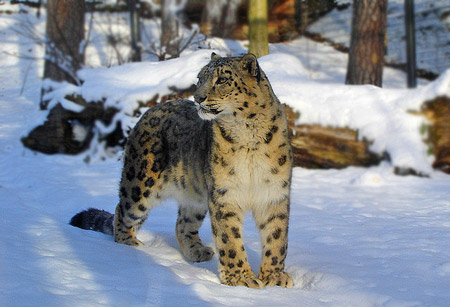By Michelle Werts
Oftentimes, environmental news follows similar themes and patterns: forests are being lost to industry, development, climate change, insect and pests, disease, etc. Every now and then, though, the news gets flipped on its head, showing that nature is a complex, interrelated web — as was the case with a few stories this week.

Usually, I come across depressing stories of how climate change is causing problems for various forests around the world — like the rapid decline of white pines in the West — so imagine my shock this week when I read about a new study in Biological Conservation that discusses how forests themselves are becoming a problem for snow leopards in the Himalayas. Forests and big cats clashing is not something I expected to come across this week, but below the surface, I discovered a more familiar foe: climate change.
Snow leopards make their homes in Asia’s high-alpine peaks — areas so high that no forest can grow there and not many other predatory species can survive. But according to the study, if greenhouse gases continue to increase, forests will creep up the Himalayas, bringing tigers and other big cats into up to 30 percent of the snow leopard’s current turf — turf that the leopards can’t afford to lose.
Less than 6,500 snow leopards exist in the wild, making the species endangered and making the loss of their habitat a very big cause for concern. To compound matters, snow leopards are an indicator species, which means if they’re in trouble, there’s a good chance the ecosystem as a whole is in trouble. Communities and governments in Nepal, India, Bhutan and China are trying to develop plans for how best to manage the snow leopard population, as no one wants to lose our “queens of the mountains.”

And, just when I finished digesting this information about snow leopards and forests, I was struck by another topsy-turvey headline: how beetles destroying plants can be a good thing. Most of the time, we hear about beetles and other insects in a negative light, such as the emerald ash borer decimating millions of ash trees across the East and Midwest, but in the Southwest, the site of a northern tamarisk beetle may actually be a good thing.
Scientists introduced the leaf beetle Diorhabda carinulataI, or northern tamarisk, to the Southwest with the intent of using it as a biocontrol against the region’s invasive tamarisk plants. Tamarisk was imported to this country centuries ago and often outcompetes common species like willow and cottonwood. Plus, it steals copious amounts of precious water supplies, as it is one thirsty plant. The northern tamarisk beetle is a natural predator of tamarisk and, since its introduction a decade ago, has rapidly evolved to the American lifestyle and is getting busy attacking tamarisk plants. Of course, the beetle isn’t without its detractors, as some groups question the use of the beetle as a biocontrol, but for the moment, the beetle seems to be settling in and performing its task well. Only time will tell if the project is ultimately a success or whether the beetle will find itself at the center of a problem of its own.